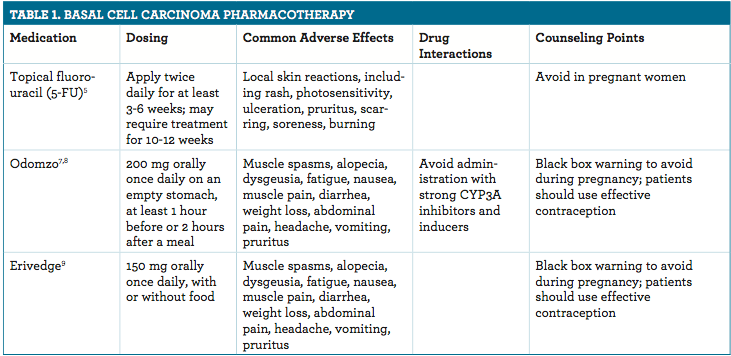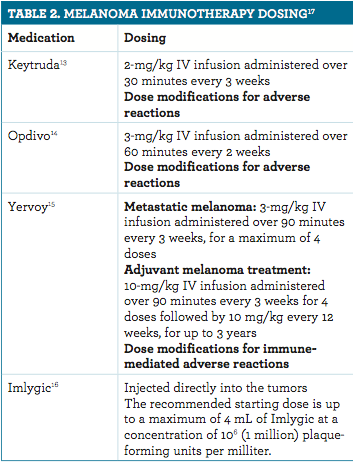Publication
Article
Pharmacy Practice in Focus: Health Systems
Skin Cancer Treatment and Prevention Recommendations
Author(s):
Basal cell carcinoma (BCC), squamous cell carcinoma (SCC), and melanoma are the 3 main types of skin cancer.
Basal cell carcinoma (BCC), squamous cell carcinoma (SCC), and melanoma are the 3 main types of skin cancer. About 5.4 million BCCs and SCCs are diagnosed each year,1 and melanoma will have accounted for more than 76,000 skin cancer cases in 2016.1 Most BCCs and SCCs are caused by exposure to ultraviolet (UV) rays from sunlight and other sources, such as tanning beds. Genetics can also play a role. Risk factors for developing melanoma include sun exposure, family history, immunosuppression (eg, organ transplant), and multiple nevi (moles). The following is a summary of skin cancer treatment and prevention recommendations.
BASAL CELL CARCINOMA
BCC generally occurs on sun-exposed areas of the skin, most commonly on the nose. It is extremely curable, especially when detected early using a variety of treatment options, including surgical procedures, radiation, photodynamic therapy (using light to remove early BCC), and topical and oral medications.2 During Mohs surgery, thin layers of cancer-containing skin are progressively removed and examined until only cancer-free tissue remains. Topical and oral treatment options are summarized in table 13,4.

Topical fluorouracil (topical 5-FU) 5% cream is an FDA-approved treatment that may be used for superficial BCC lesions or difficult treatment sites.5 Imiquimod topical therapy acts as an immunomodulatory agent, but is not generally recommended as a first-line treatment for BCC; therefore, it is usually reserved for patients with small lesions in low-risk sites.4,5 After treatment for BCC, patients should be followed and examined regularly. Generally, most recurrences happen within 5 years.3 Mohs surgery is commonly used for local recurrences of BCC. Two medications, Erivedge (vismodegib) and Odomzo (sonidegib), are approved for the treatment of locally advanced BCC. They inhibit the Hedgehog molecular pathway, which is active in BCC.
SQUAMOUS CELL CARCINOMA
Surgical excision is the most common treatment for SCC. Mohs surgery is used to achieve the narrowest margins to avoid tumor recurrence.3 If a recurrence is nonmetastatic SCC, then it is usually treated with Mohs. Local SCC recurrence rates range from about 3% to 23% depending upon the site. If the SCC cannot be removed through surgery, then radiation therapy is used. It is rare for patients to develop metastatic SCC, and there is limited available therapy evidence. Cisplatin-based therapies may be associated with high initial tumor response rates, however.10 Keytruda (pembrolizumab) received accelerated approval in August 2016 for recurrent or metastatic head and neck SCC with disease progression on or after platinum-containing chemotherapy.11 The recommended dose is 200 mg IV infusion over 30 minutes every 3 weeks. The most common adverse reactions include fatigue, decreased appetite, and dyspnea.
MELANOMA
Surgical excision is the first-line treatment for melanoma; more advanced melanoma may require other treatments. There are 3 main methods of treating melanoma: immunotherapy, targeted therapy, and chemotherapy.12 Chemotherapy can be used to treat advanced melanoma, but it is not generally given as first-line treatment because immunotherapy and targeted drugs have become available.
Immunotherapy includes immune checkpoint inhibitors, cytokines, and oncolytic virus therapy.12 Keytruda and Opdivo (nivolumab) are PD-1 inhibitors, which boost the immune response against melanoma cells.13,14 Common adverse effects (AEs) include fatigue, cough, nausea, itching, skin rash, decreased appetite, constipation, joint pain, and diarrhea. Yervoy (ipilimumab) is a CTLA-4 inhibitor that also boosts the immune system.15 The most common AEs are fatigue, diarrhea, skin rash, and itching. Cytokines are proteins that boost the immune system, too. Interferon-alfa and interleukin-2 are administered as IV infusions. AEs include flu-like symptoms and edema. Oncolytic viruses work by infecting and killing cancer cells directly. Imlygic (talimogene laherparepvec) is an oncolytic virus used to treat melanomas in the skin or lymph nodes that cannot be removed with surgery.16 AEs include flu-like symptoms and pain at the injection site. See table 217 and online table 317 for dosing information.

TABLE 3. MELANOMA TARGETED THERAPY DOSING17
Medication
Dosing
Zelboraf
960 mg (four 240-mg tablets) orally twice daily, taken 12 hours apart
Dose modifications for adverse reactions
Tafinlar
150 mg orally twice daily, taken 12 hours apart as monotherapy or with Mekinist
Take Tafinlar at least 1 hour before or 2 hours after a meal
Dose modifications for adverse reactions
Mekinist
2 mg orally once daily, as monotherapy or with Tafinlar
Take Mekinist at least 1 hour before or 2 hours after a meal
Dose modifications for adverse reactions
Cotellic
60 mg (three 20-mg tablets) orally once daily for the first 21 days of each 28-day cycle
Used in combination with Zelboraf
Dose modifications for adverse reactions
Targeted therapies have an isolated a number of oncogenic DNA mutations and potential therapeutic targets,17 and include BRAF inhibitors and MEK inhibitors. Approximately half of all melanomas have mutations in the BRAF gene.17 Zelboraf (vemurafenib) and Tafinlar (dabrafenib) attack the BRAF protein directly and shrink or slow the growth of tumors whose metastatic melanoma has a BRAF gene mutation. Common AEs include skin thickening, rash, itching, photosensitivity, headache, fever, joint pain, fatigue, alopecia, and nausea. Because the MEK gene works with the BRAF gene, medications that block MEK proteins can also help treat melanomas with BRAF mutations. Mekinist (trametinib) and Cotellic (cobimetinib), both MEK inhibitors, have been shown to shrink some melanomas with BRAF mutations. Common AEs include rash, nausea, diarrhea, and photosensitivity.When used as monotherapy, MEK inhibitors are not as effective for treating melanomas as BRAF inhibitors.3 Therefore, it is more effective to use a combination therapy of MEK and BRAF inhibitors.
PREVENTION STRATEGIES
Educate patients to use broad spectrum sunscreens with an SPF of 30 or higher that includes UV-A and UV-B protection.18 Sunscreen should be reapplied every 2 hours or after swimming or sweating. Teach patients about the warning signs of melanoma and the importance of consulting a dermatologist (see online table 418). Indoor tanning, such as the use of beds, booths, or sunlamps, can increase the risk of developing cancer and should be avoided. The FDA issued a proposed rule to restrict the use of sunlamp products to individuals aged 18 and older.19
TABLE 4. MELANOMA WARNING SIGNS: ABCDE18
A = Asymmetry
Each mole half is different
B = Border
Irregular or poorly defined border
C = Color
Shades of tan, brown, or black or is sometimes white, red, or blue
D = Diameter
Mole greater than 6 mm (size of pencil eraser)
E = Evolving
Mole is changing in size, shape, or color
CONCLUSION
Pharmacists can play an important role in educating patients on skin cancer prevention strategies, including the use of sunscreen and melanoma warning signs. Surgical excision is generally the most common initial treatment for BCC, SCC, and melanoma. Erivedge and Odomzo are reserved for advanced BCC. Cisplatin-based therapies and Keytruda are used to treat rare cases of metastatic SCC. Immunotherapy, targeted therapy, and chemotherapy are options for advanced melanoma.
JENNIFER GERSHMAN, PHARMD, CPH, is a medical writer and Pharmacy Times® contributor residing in south Florida.
REFERENCES
- Skin cancer facts. American Cancer Society website. cancer.org/cancer/cancercauses/sunanduvexposure/skin-cancer-facts. Accessed August 25, 2016.
- Bath-Hextall FJ, Perkins W, Bong J, Williams HC. Interventions for basal cell carcinoma of the skin. Cochrane Database Syst Rev. 2007;(1):CD003412.
- National Cancer Institute. Skin cancer treatment (PDQ)—health professional version. National Cancer Institute website. cancer.gov/types/skin/hp/skin-treatment-pdq. Updated January 29, 2016. Accessed August 27, 2016.
- Love WE, Bernhard JD, Bordeaux JS. Topical imiquimod or fluorouracil therapy for basal and squamous cell carcinoma: a systematic review. Arch Dermatol. 2009;145(12):1431-1438. doi: 10.1001/archdermatol.2009.291.
- Fluorouracil cream [package insert]. Morgantown, WV: Mylan Pharmaceuticals; 2013.
- Aldara cream [package insert]. Bridgewater, NJ: Valeant Pharmaceuticals; 2014.
- Odomzo [package insert]. East Hanover, NJ: Novartis Pharmaceuticals; 2015.
- FDA approves new treatment for most common form of advanced skin cancer [news release]. Silver Spring, MD: FDA; July 24, 2015. www.fda.gov/NewsEvents/Newsroom/PressAnnouncements/ucm455862.htm. Accessed August 30, 2016.
- Erivedge [package insert]. South San Francisco, CA: Genentech; 2015.
- Sadek H, Azli N, Wendling JL, et al. Treatment of advanced squamous cell carcinoma of the skin with cisplatin, 5-fluorouracil, and bleomycin. Cancer. 1990;66(8):1692-1696.
- Pembrolizumab (Keytruda). FDA website. www.fda.gov/Drugs/InformationOnDrugs/ApprovedDrugs/ucm515627.htm. Updated August 9, 2016. Accessed September 3, 2016.
- American Cancer Society medical and editorial team. Immunotherapy for melanoma skin cancer. ACS website. cancer.org/cancer/skincancer-melanoma/detailedguide/melanoma-skin-cancer-treating-immunotherapy. Updated May 19, 2016. Accessed September 6, 2016.
- Keytruda [package insert]. Whitehouse Station, NJ: Merck & CO; 2016.
- Opdivo [package insert]. Princeton, NJ: Bristol-Myers Squibb Company; 2016.
- Yervoy [package insert]. Princeton, NJ: Bristol-Myers Squibb Company; 2016.
- Imlygic [package insert]. Thousand Oaks, CA: BioVex; 2015.
- Tang T, Eldabaje R, Yang L. Current status of biological therapies for the treatment of metastatic melanoma. Anticancer Res. 2016;36(7):3229-3241.
- Prevent skin cancer. American Academy of Dermatology website. aad.org/public/spot-skin-cancer/learn-about-skin-cancer/prevent. Accessed September 8, 2016.
- FDA proposes tanning bed age restrictions and other important safety measures [news release]. Silver Spring, MD: FDA; December 18, 2015. www.fda.gov/NewsEvents/Newsroom/PressAnnouncements/ucm477434.htm. Accessed August 25, 2016.







